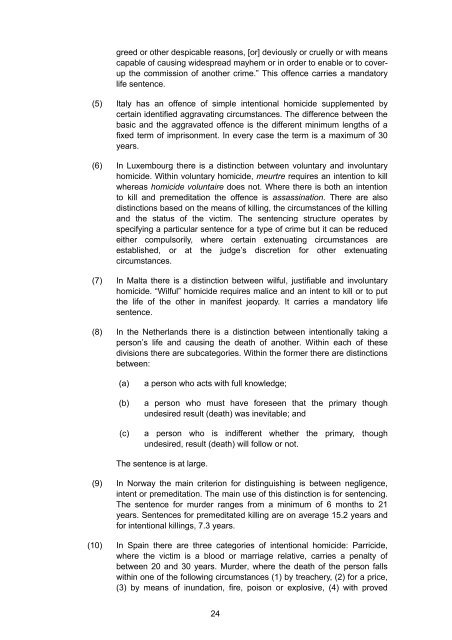lc290 Partial Defences to Murder report - Law Commission
lc290 Partial Defences to Murder report - Law Commission
lc290 Partial Defences to Murder report - Law Commission
You also want an ePaper? Increase the reach of your titles
YUMPU automatically turns print PDFs into web optimized ePapers that Google loves.
greed or other despicable reasons, [or] deviously or cruelly or with means<br />
capable of causing widespread mayhem or in order <strong>to</strong> enable or <strong>to</strong> coverup<br />
the commission of another crime.” This offence carries a manda<strong>to</strong>ry<br />
life sentence.<br />
(5) Italy has an offence of simple intentional homicide supplemented by<br />
certain identified aggravating circumstances. The difference between the<br />
basic and the aggravated offence is the different minimum lengths of a<br />
fixed term of imprisonment. In every case the term is a maximum of 30<br />
years.<br />
(6) In Luxembourg there is a distinction between voluntary and involuntary<br />
homicide. Within voluntary homicide, meurtre requires an intention <strong>to</strong> kill<br />
whereas homicide voluntaire does not. Where there is both an intention<br />
<strong>to</strong> kill and premeditation the offence is assassination. There are also<br />
distinctions based on the means of killing, the circumstances of the killing<br />
and the status of the victim. The sentencing structure operates by<br />
specifying a particular sentence for a type of crime but it can be reduced<br />
either compulsorily, where certain extenuating circumstances are<br />
established, or at the judge’s discretion for other extenuating<br />
circumstances.<br />
(7) In Malta there is a distinction between wilful, justifiable and involuntary<br />
homicide. “Wilful” homicide requires malice and an intent <strong>to</strong> kill or <strong>to</strong> put<br />
the life of the other in manifest jeopardy. It carries a manda<strong>to</strong>ry life<br />
sentence.<br />
(8) In the Netherlands there is a distinction between intentionally taking a<br />
person’s life and causing the death of another. Within each of these<br />
divisions there are subcategories. Within the former there are distinctions<br />
between:<br />
(a) a person who acts with full knowledge;<br />
(b) a person who must have foreseen that the primary though<br />
undesired result (death) was inevitable; and<br />
(c) a person who is indifferent whether the primary, though<br />
undesired, result (death) will follow or not.<br />
The sentence is at large.<br />
(9) In Norway the main criterion for distinguishing is between negligence,<br />
intent or premeditation. The main use of this distinction is for sentencing.<br />
The sentence for murder ranges from a minimum of 6 months <strong>to</strong> 21<br />
years. Sentences for premeditated killing are on average 15.2 years and<br />
for intentional killings, 7.3 years.<br />
(10) In Spain there are three categories of intentional homicide: Parricide,<br />
where the victim is a blood or marriage relative, carries a penalty of<br />
between 20 and 30 years. <strong>Murder</strong>, where the death of the person falls<br />
within one of the following circumstances (1) by treachery, (2) for a price,<br />
(3) by means of inundation, fire, poison or explosive, (4) with proved<br />
24

















